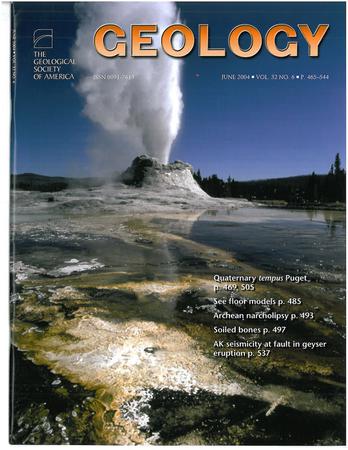停滞的俯冲板块加速了地球深处的碳循环
IF 4.6
1区 地球科学
Q1 GEOLOGY
引用次数: 0
摘要
大量的碳可以被输送到亚弧深度以外的更深的地幔中,因此很可能参与长时间尺度的地幔过程。然而,碳在地幔深部的停留时间仍存在争议。晚中生代以来,古太平洋板块一直处于东北亚地幔过渡带(MTZ)内,主导着地幔过渡带上方的深部碳循环。我们重建了中生代晚期至新生代早期古太平洋板块的碳消减通量,发现碳在亚弧深度以外的转移范围为1.4 ~ 14.9 Mt/yr。同时,对白垩纪-新生代板内玄武岩Sr - Nd - Pb - Zn同位素数据分析表明,其地幔源中含有0.4 ~ 1.4 wt%来自俯冲板块的再生碳。随着时间的推移,碳消减通量和再循环碳量表现出相似的趋势,包括3次相应的突变减少和主要碳储层由蚀变洋壳向沉积物的转变。这两个趋势之间的平均滞后时间为17 μ m.,反映了与东北亚停滞板块相关的俯冲碳停留时间相对较短。这些结果表明,滞流板块可以加速深部碳循环,并对俯冲动力学产生强烈影响。本文章由计算机程序翻译,如有差异,请以英文原文为准。
A stagnant subducted slab accelerates the deep Earth carbon cycle
Substantial amounts of carbon can be transported into the deeper mantle beyond sub-arc depths and are thus likely to participate in mantle processes over long time scales. However, the residence time of carbon in the deep mantle remains debated. The (Paleo-)Pacific plate has been stagnating in the mantle transition zone (MTZ) beneath northeast Asia since the late Mesozoic, dominating deep carbon cycling above the MTZ. We reconstruct the carbon subduction flux from the (Paleo-)Pacific plate during the late Mesozoic to early Cenozoic, revealing that carbon transported beyond the sub-arc depths range from 1.4 to 14.9 Mt/yr. Meanwhile, analysis of Sr−Nd−Pb−Zn isotope data for Cretaceous−Cenozoic intraplate basalts shows that their mantle sources contained 0.4−1.4 wt% of recycled carbon derived from the subducting slab. Over time, the carbon subduction flux and the amount of recycled carbon exhibit similar trends, including three corresponding abrupt decreases and a transition of the predominant carbon reservoir from altered oceanic crust to sediments. An average time lag of 17 m.y. between the two trends reflects a relatively short residence time for subducted carbon associated with the stagnant slab in northeast Asia. These results indicate that stagnant slabs can accelerate the deep carbon cycle and exert a strong effect on subduction dynamics.
求助全文
通过发布文献求助,成功后即可免费获取论文全文。
去求助
来源期刊

Geology
地学-地质学
CiteScore
10.00
自引率
3.40%
发文量
228
审稿时长
6.2 months
期刊介绍:
Published since 1973, Geology features rapid publication of about 23 refereed short (four-page) papers each month. Articles cover all earth-science disciplines and include new investigations and provocative topics. Professional geologists and university-level students in the earth sciences use this widely read journal to keep up with scientific research trends. The online forum section facilitates author-reader dialog. Includes color and occasional large-format illustrations on oversized loose inserts.
 求助内容:
求助内容: 应助结果提醒方式:
应助结果提醒方式:


